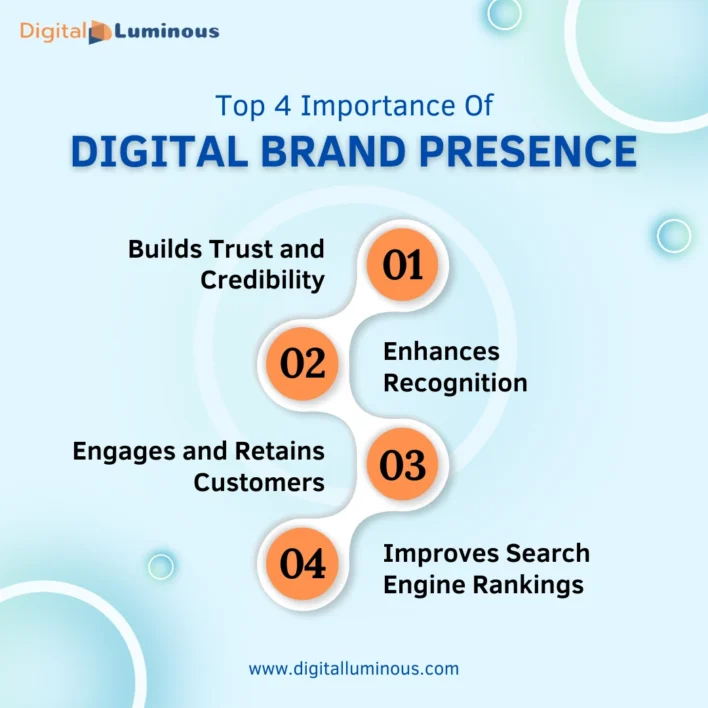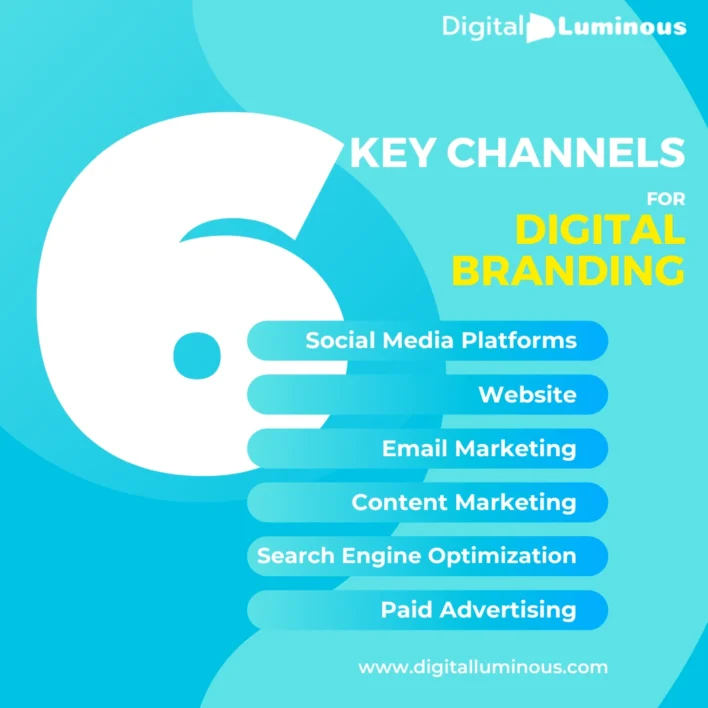
In today’s digital age, establishing a robust online presence is essential for any brand seeking to thrive. The competition is fierce, and consumers are constantly bombarded with information from various sources. To stand out, brands must effectively manage their digital presence across multiple channels.
This article explores strategies and best practices for building a strong digital brand presence, offering insights and examples from cities across the USA to help you understand and implement these tactics.
The Importance of a Strong Digital Brand Presence

Before diving into strategies, it’s crucial to understand why a strong digital brand presence is vital. A cohesive online presence:
- Builds Trust and Credibility: Consistent messaging and branding across channels create a professional image, making customers more likely to trust your brand.
- Enhances Recognition: Uniform branding helps consumers easily recognize your brand, whether they encounter it on social media, your website, or in email communications.
- Engages and Retains Customers: A strong online presence allows you to engage with your audience, providing value and fostering loyalty.
- Improves Search Engine Rankings: Consistent content and engagement across channels can boost your SEO efforts, making your brand more discoverable.
Understanding Multi-Channel Branding
Multi-channel branding involves maintaining a consistent brand identity across various digital platforms such as social media, websites, email marketing, and more. The goal is to create a seamless experience for your audience, no matter where they interact with your brand.
Key Channels for Digital Branding

Digital branding is not limited to just one or two platforms. The best way to get your brand recognized and leave a digital footprint on the internet, these are our recommendations for key channels for Digital Branding:
- Social Media Platforms: Facebook, Instagram, Twitter, LinkedIn, and Pinterest.
- Website: Your central hub for information and content.
- Email Marketing: Personalized communication with your audience.
- Content Marketing: Blogs, videos, podcasts, and infographics.
- Search Engine Optimization (SEO): Ensuring your content is discoverable.
- Paid Advertising: Google Ads, social media ads, and other paid campaigns.
Strategies for Building a Strong Digital Brand Presence
1. Develop a Clear Brand Identity
Strategy: Your brand identity is the foundation of your digital presence. It includes your logo, color scheme, typography, and voice.
Example: A tech startup in Austin, Texas, might choose a modern, sleek logo and a color scheme that reflects innovation and creativity. Their brand voice could be friendly and knowledgeable, appealing to their tech-savvy audience.
2. Create a Consistent Brand Voice and Messaging
Strategy: Consistency in your brand voice and messaging helps build trust and recognition. Define your brand’s tone and ensure it is used uniformly across all channels.
Example: A healthcare provider in Boston could adopt a compassionate and professional tone, ensuring that their website content, social media posts, and email newsletters all reflect this voice.
3. Optimize Your Website
Strategy: Your website is often the first point of contact for potential customers. Ensure it is user-friendly, visually appealing, and optimized for search engines.
Example: A boutique hotel in San Francisco might invest in a responsive website design that showcases stunning images of their rooms and amenities, with easy navigation and clear calls to action. SEO optimization ensures that potential guests can find them easily through search engines.
4. Leverage Social Media
Strategy: Social media platforms are powerful tools for engaging with your audience and building brand awareness. Choose platforms that align with your target audience and consistently post relevant content.
Example: A fashion retailer in New York City might use Instagram to showcase their latest collections, Facebook to share customer reviews and stories, and Twitter for real-time updates and promotions.
5. Invest in Content Marketing
Strategy: High-quality content can establish your brand as an authority in your industry and provide value to your audience. Develop a content strategy that includes blogs, videos, podcasts, and infographics.
Example: A fitness brand in Los Angeles could create a blog offering workout tips, nutritional advice, and success stories. They could also produce videos demonstrating exercises and sharing motivational content.
6. Utilize Email Marketing
Strategy: Email marketing allows for personalized communication with your audience. Send regular newsletters, promotional offers, and updates to keep your audience engaged.
Example: A coffee shop chain in Seattle could send monthly newsletters featuring new coffee blends, upcoming events, and exclusive discounts to their subscribers, fostering a loyal customer base.
7. Implement SEO Best Practices
Strategy: SEO is crucial for improving your brand’s visibility online. Optimize your website and content for relevant keywords, build high-quality backlinks, and ensure your site is mobile-friendly.
Example: An eco-friendly product company in Denver might create a series of blog posts focused on sustainable living, optimizing them for keywords related to eco-friendly products and practices. This helps attract organic traffic from search engines.
8. Engage with Your Audience
Strategy: Engagement is key to building a loyal community. Respond to comments, participate in conversations, and show appreciation for your audience’s support.
Example: A pet store in Chicago could actively engage with their followers on social media by responding to comments, hosting Q&A sessions, and featuring customer pet photos. This fosters a sense of community and loyalty.
9. Monitor and Analyze Performance
Strategy: Regularly monitor your digital presence across all channels to understand what’s working and what needs improvement. Use analytics tools to track performance and make data-driven decisions.
Example: A real estate agency in Miami might use Google Analytics to track website traffic, social media insights to monitor engagement, and email marketing metrics to assess the success of their campaigns. Adjusting strategies based on these insights can lead to better results.
10. Adapt and Evolve
Strategy: The digital landscape is constantly changing. Stay updated with the latest trends and technologies, and be willing to adapt your strategies as needed.
Example: A software company in Silicon Valley could stay ahead of the curve by regularly updating their technology stack, adopting new social media platforms, and experimenting with emerging content formats like virtual reality or live streaming.
11. Foster Partnerships and Collaborations
Strategy: Collaborating with other brands or influencers can expand your reach and introduce your brand to new audiences.
Example: A craft brewery in Portland, Oregon, might partner with a local food truck to host joint events. They could also collaborate with influencers in the food and beverage industry to promote their brand on social media, reaching a broader audience.
12. Use Data to Personalize Experiences
Strategy: Leverage data analytics to personalize your marketing efforts. Tailored content and offers can significantly enhance customer engagement and loyalty.
Example: An e-commerce store in Philadelphia might analyze customer purchase history and browsing behavior to send personalized product recommendations and exclusive offers via email. This targeted approach can increase conversion rates and customer satisfaction.
13. Focus on Visual Content
Strategy: Visual content is highly engaging and shareable. Incorporate high-quality images, infographics, and videos into your digital marketing strategy.
Example: A travel agency in San Diego could use stunning visuals of popular travel destinations in their social media posts and blog articles. They could also create video tours and customer testimonials to captivate their audience and inspire travel.
14. Implement Retargeting Campaigns
Strategy: Retargeting ads can remind visitors of your brand and encourage them to return and complete a purchase.
Example: An online clothing retailer in Houston could use Facebook Pixel to track website visitors and serve them targeted ads featuring the products they viewed but didn’t purchase. This can increase conversion rates and boost sales.
15. Encourage User-Generated Content
Strategy: User-generated content (UGC) can enhance your brand’s authenticity and credibility. Encourage your customers to share their experiences and tag your brand on social media.
Example: A restaurant in New Orleans might run a contest asking customers to share photos of their meals and tag the restaurant for a chance to win a free dinner. This generates UGC and increases social media engagement.
16. Optimize for Voice Search
Strategy: With the rise of voice-activated assistants like Alexa and Siri, optimizing your content for voice search is becoming increasingly important.
Example: A home improvement store in Dallas could create content that answers common questions homeowners might ask through voice search, such as “How to fix a leaky faucet” or “Best paint colors for living rooms.” This can help attract traffic from voice searches.
17. Utilize Local SEO
Strategy: If your business operates in specific locations, local SEO can help you attract customers in your area. Optimize your Google My Business listing and include location-specific keywords in your content.
Example: A dental clinic in Orlando could optimize their Google My Business profile with accurate information, positive reviews, and high-quality images. They could also create blog posts targeting local keywords like “best dentist in Orlando” to improve their local search rankings.
18. Create Interactive Content
Strategy: Interactive content, such as quizzes, polls, and surveys, can engage your audience and provide valuable insights into their preferences and behaviors.
Example: A beauty brand in Beverly Hills might create a quiz to help customers find the perfect skincare routine based on their skin type and concerns. This interactive content can increase engagement and drive traffic to their website.
19. Focus on Mobile Optimization
Strategy: Ensure that your digital presence is optimized for mobile devices, as a significant portion of online traffic comes from mobile users.
Example: A food delivery service in San Jose could ensure their website and app are mobile-friendly, with easy navigation and quick load times. This enhances the user experience and can lead to higher conversion rates.
20. Host Webinars and Live Events
Strategy: Webinars and live events can position your brand as an authority in your industry and provide value to your audience.
Example: A financial advisory firm in Atlanta might host webinars on topics like retirement planning or investment strategies. They could promote these events through email marketing and social media, attracting a large audience and generating leads.
21. Build a Community
Strategy: Creating a community around your brand can foster loyalty and engagement. Use social media groups, forums, and online communities to connect with your audience.
Example: A bookshop in Brooklyn could create a Facebook group for book lovers, where they can discuss their favorite books, share recommendations, and participate in virtual book club meetings. This builds a sense of community and keeps the audience engaged with the brand.
Integrating Multi-Channel Strategies
A holistic example of multi-channel branding is a wellness brand based in Portland, Oregon. They have a user-friendly website optimized for SEO, regularly updated with blog posts on wellness tips. Their Instagram account showcases beautiful imagery and user-generated content, while their Facebook page shares customer testimonials and upcoming events.
They send monthly newsletters with exclusive content and offers, and their YouTube channel features yoga tutorials and meditation guides. By maintaining a consistent brand identity across these channels, they create a seamless and engaging experience for their audience.
The Role of Paid Advertising
Strategy: Paid advertising can amplify your reach and attract new customers. Use platforms like Google Ads and social media ads to target specific demographics and interests.
Example: An online education platform in Philadelphia might use Facebook Ads to target parents of high school students, promoting their latest courses and offering a discount for early sign-ups. This targeted approach can drive traffic to their website and increase conversions.
Challenges in Multi-Channel Branding

Maintaining Consistency
Challenge: Ensuring consistent messaging and branding across multiple channels can be challenging, especially as your brand grows.
Solution: Create a comprehensive brand guide that includes guidelines for tone, style, color schemes, fonts, and more. Regularly review your content to ensure alignment with these guidelines.
Resource Allocation
Challenge: Managing multiple channels effectively requires time and resources, which can be a strain on smaller businesses.
Solution: Prioritize the channels that offer the most value and focus your efforts there. Use automation tools to schedule posts, manage emails, and analyze performance, freeing up time for strategic planning.
Measuring Success
Challenge: Measuring the success of your multi-channel branding efforts can be complex, as each channel has different metrics and KPIs.
Solution: Define clear goals for each channel and use analytics tools to track progress. Regularly review and adjust your strategies based on data insights to optimize performance.
Building a strong digital brand presence across multiple channels is essential in today’s competitive landscape. By developing a clear brand identity, creating consistent messaging, optimizing your website, leveraging social media, investing in content marketing, utilizing email marketing, implementing SEO best practices, engaging with your audience, monitoring performance, and adapting to changes, you can create a cohesive and compelling brand experience that resonates with your audience.
Remember, the key to successful multi-channel branding is consistency. Ensure that your brand’s voice, visuals, and messaging are aligned across all platforms to build trust, enhance recognition, and drive engagement. With these strategies in place, your brand will be well-positioned to thrive in the digital world.
FAQs
What is digital brand presence?
Digital brand presence refers to how your brand appears and is perceived online. It encompasses your website, social media profiles, content, and interactions. A strong digital presence ensures that your brand is visible, recognizable, and trusted by your target audience. It involves consistent branding, engaging content, and active participation across various digital platforms.
Why is a strong digital brand presence important?
A strong digital brand presence is crucial for building trust and credibility with your audience. It enhances brand recognition, improves customer engagement, and can lead to higher conversion rates. In today’s digital world, consumers often interact with brands online before making purchasing decisions, making a robust digital presence essential for success.
How can I develop a clear brand identity?
Developing a clear brand identity involves defining your brand’s values, mission, and unique selling proposition. Create a cohesive visual identity with a consistent logo, color scheme, and typography. Your brand voice should reflect your values and resonate with your target audience. Document these elements in a brand guide to ensure consistency across all channels.
What are some effective social media strategies for branding?
Effective social media strategies include posting consistently, using high-quality visuals, and engaging with your audience. Tailor your content to each platform and use analytics to track performance. Collaborate with influencers and run targeted ads to expand your reach. Regularly update your strategy based on trends and audience feedback.
How does content marketing help in building a digital brand?
Content marketing helps establish your brand as an authority in your industry by providing valuable information to your audience. It improves SEO, drives traffic to your website, and fosters customer loyalty. High-quality content, such as blog posts, videos, and infographics, can engage your audience and encourage them to share your brand with others.
What role does email marketing play in digital branding?
Email marketing allows for personalized communication with your audience. It helps build relationships, keep customers informed, and drive conversions. Regular newsletters, promotional offers, and personalized recommendations can keep your audience engaged and foster loyalty. Use email marketing tools to segment your audience and track campaign performance.
Why is SEO important for digital branding?
SEO is essential for improving your brand’s visibility online. It helps your content rank higher in search engine results, making it easier for potential customers to find you. Effective SEO strategies include optimizing your website, creating high-quality content, and building backlinks. A strong SEO presence can drive organic traffic and enhance brand credibility.
How can I ensure consistency in my brand messaging?
To ensure consistency in brand messaging, develop a comprehensive brand guide that outlines your voice, tone, and visual elements. Train your team to adhere to these guidelines across all channels. Regularly review your content to ensure it aligns with your brand identity. Consistent messaging builds trust and reinforces brand recognition.
What are some common challenges in multi-channel branding?
Common challenges include maintaining consistency, allocating resources effectively, and measuring success across different channels. Each platform has unique requirements, making it difficult to maintain a uniform brand identity. To overcome these challenges, prioritize high-impact channels, use automation tools, and regularly analyze performance to adjust your strategies.
How can I engage with my audience effectively?
Effective audience engagement involves responding to comments and messages, participating in conversations, and showing appreciation for your audience’s support. Use interactive content like polls, quizzes, and live events to foster engagement. Personalize your interactions and provide valuable content that resonates with your audience’s interests and needs.
What is the role of data in personalizing marketing efforts?
Data analytics allows you to understand your audience’s preferences and behaviors, enabling personalized marketing efforts. By analyzing purchase history, browsing behavior, and demographic information, you can tailor your content and offers to individual customers. Personalized marketing enhances engagement, improves customer satisfaction, and increases conversion rates.
How can I stay updated with digital marketing trends?
Stay updated with digital marketing trends by following industry blogs, attending webinars, and participating in professional networks. Subscribe to newsletters from leading marketing platforms and regularly review analytics to understand evolving audience preferences. Experiment with new tools and strategies to stay ahead of the curve and adapt to changes in the digital landscape.


